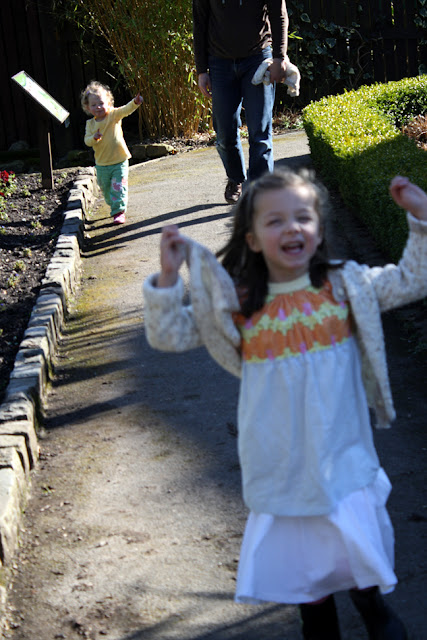One of the things I love about being able to operate a sewing machine is that often, when I think 'you know, right now something like
x,y,z would be useful...' I don't have to go and scour the shops/internet to find it - I can just go home and have a bash at making it myself, and even save a bit of money in the process.
I'm trying to be outdoors with the girls as much as possible at the moment, and snack stops on wet spring grass mean they need something to sit on. Our big picnic blanket is far too big to stuff into my bag (already overloaded with changing things, snacks, drinks, sunblock, etc etc). We have a few play mats that are about the right size but they would just end up soggy.
What we really, really needed something exactly like this:
It's lightweight. It's comfortable. It's a mini picnic quilt that's perfect for two. It's backed by waterproof polyester, and if it does get dirty, it's machine washable. It's the You and Me mat, and here's how I made it.
Materials
- Sewing machine with walking foot installed.
- Disappearing fabric pen.
- Hair grips (the metal sort with one wavy edge and one straight edge; we call them bobby pins).
- A piece of lightweight cotton for the top, sized 1/2" bigger all round than the desired mat size. I used a 37" x 27" piece of this "Gullan" cotton from Ikea featuring an appropiate food-splodged print, and I pre-washed and dried it.
- A piece of lightweight cotton for the ties (40" x 4" for the size of mat I made, I used a leftover bit from cutting the top piece).
- A piece of quilt batting cut approx 1/2" - 1" larger all round than the cotton top piece. ( I used Sew Simple 80/20 cotton blend)
- A piece of lightweight ripstop polyester, sized 4" bigger all round than the desired mat size. (The fabric I used was 130grams/square metre).
Instructions
1. Sew the quilted top
Place the cotton top piece on top of the batting and pin all round. With the walking foot installed, stitch around the edges with a 1/2" allowance (from the edge of the cotton top piece). Then, using a disappearing fabric pen, mark lines at equal intervals along the length. I used a 3" interval. Pin in the spaces between your lines to stop the layers from shifting, then machine stitch along the lines.
(Here's the top quilted at a 6" spacing. I then went back and added another set of lines to make the spacing 3").
Trim neatly around the quilted top, cutting through both layers to an allowance of 1/4" (from the stitched border), thereby making the top the size of the finished mat.
2. Attach the backing.
Place the piece of ripstop polyester on a flat surface, wrong size up (on my piece one side was slightly shinier than the other). Place the quilted top centrally on top, so 2" of the backing is visible all around.
You can't iron the polyester because it will melt, and you can't pin it either because any holes made will be permanent. So you have to fold and press the backing over the quilted top by hand, and secure with something that doesn't puncture the fabric. I used hair grips.
Fold over each edge by 1" to meet the edge of the quilted top, and then 1" again to overlap the top. At the corners, fold each corner of the polyester in underneath the corner of the quilted top to make a neat corner in the binding. Hold in place with the hair grips.
(You can also fold the corners like
this). Continue all the way around.
3. Machine stitch the backing to the quilt top.
Large machine needles can rip big holes in the polyester fabric, so you now need to switch to a thin needle. I used a size 9, which didn't seem to be a problem with this thin cotton fabric and fairly lightweight wadding.
Still with the walking foot installed, sew around the top of the quilt, 1/4" from the inside edge of the binding.
I found this wasn't enough to secure the folded corners, so I pulled them to overlap a little and stitched close to the join.
To finish off and hold in place, edgestitch a second row of stitches on the binding close to the join with the quilt top.
4. Make and attach the ties
To make the ties, Take a 40"x4" strip of fabric and fold in half to make a 40" by 2" strip. Press, then open up and fold each long edge toward the crease. Press again, tucking in 1/2" at each short end, then fold in half so the folded edges are together, making a 40" by 1" strip. Press and pin in place, then machine stitch 1/8" from the edges to hold it all together.
Place the tie on the reverse of the mat, on one of the long sides, 1/8 of the long edge length (about 4 1/2 ") from the corner, with the middle of the tie positioned over the mat's stitch lines. Sew in place by following the two existing stitch lines. (With the mat unfolded, obviously.)
Roll the finished mat up by folding along the long edge, then folding again, then rolling towards the ties.
All ready to take out on expedition!
Just to the back garden...
Or further afield. (A field).
Washing tip: a 40 degree wash on a gentle spin cycle seemed fine, but probably best not to tumble dry.
Happy sewing!
(Personal use only - please do not sell items made from this tutorial, thanks)























































